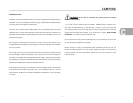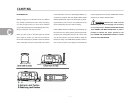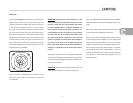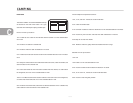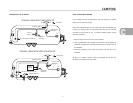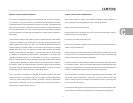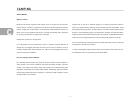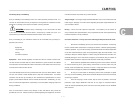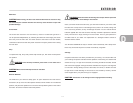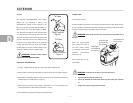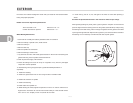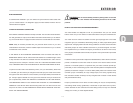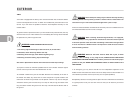
C
C - 10
CAMPING
Controlling Sway or Fishtailing
Sway or fishtailing is the sideways action of a trailer caused by external forces. It is
common for travel trailers to sway in response to strong winds or crosswinds or when
passed by or passing a semi-tractor and trailer or driving downhill.
WARNING: Excessive sway or fishtailing of your travel trailer can lead
to the rollover of the trailer and tow vehicle. Serious injury or death can occur. It is
important that you read and understand the information in this section.
Sway or fishtailing of your recreation vehicle can be controlled and is primarily im-
pacted by four factors:
· Equipment
· Tongue weight
· Driving
· Corrective measures
Equipment – When hitched together, the trailer and the tow vehicle must be level.
The tires of both the trailer and tow vehicle should be in good condition and inflated
to the pressure recommended as noted on the exterior of the trailer and in the owner’s
manuals of the trailer and tow vehicle.
Your trailer brakes should work in synchronization with your tow vehicle brakes. Never
use your tow vehicle or trailer brakes alone to stop the combined load. Your brake
controller must be set up according to the manufacturer’s specifications to ensure
proper synchronization between the tow vehicle and the trailer. Additionally, you may
have to make small adjustments occasionally to accommodate changing loads and
driving conditions.
Also, we recommend a friction sway damper or hitch with built-in sway control be
provided for your unit. Please consult your dealer regarding this equipment, as the RV
manufacturer does not provide sway control devices.
Tongue weight – The tongue weight should be between 10% to 15% of the total travel
trailer weight. See page xxx of this manual regarding the proper weight distribution of
your recreation vehicle.
Driving – This is the most important component. The tendency for the vehicle to
sway increases with speed therefore, obey all speed limits and reduce speed during
inclement weather or windy conditions.
Corrective measures – If sway occurs the following techniques should be used:
1. Slow down immediately, remove your foot from the accelerator. Avoid using
the tow vehicle brakes unless there is a danger of collision. Reduce speed gradually
whenever possible. If you can do so safely, use the brake hand controller (independent
of the tow vehicle brakes) to gently and progressively apply the trailer brakes. This
will help to keep the vehicles aligned. Practice using the brake hand controller on a
deserted parking lot. Don’t wait until an emergency occurs before using it. Location of
the brake hand controller is important and should be made easily accessible.
2. Steer as little as possible while maintaining control of the vehicle. Because
of natural reaction lag time, quick steering movements to counter trailer sway will
actually cause increased sway and loss of control. Keep both hands on the wheel.
Hold the wheel as straight as possible until stability is regained.
3. Do not jam on the brakes or attempt to press on the accelerator to speed
your way out of the fishtailing. Both actions make the situation worse and could cause
severe injury or death.
4. Once the swaying is under control, stop as soon as possible. Check tire
pressures, cargo weight distribution and look for any signs of mechanical failure.
Travel at reduced speeds that permit full control until the problem can be identified
and corrected.



